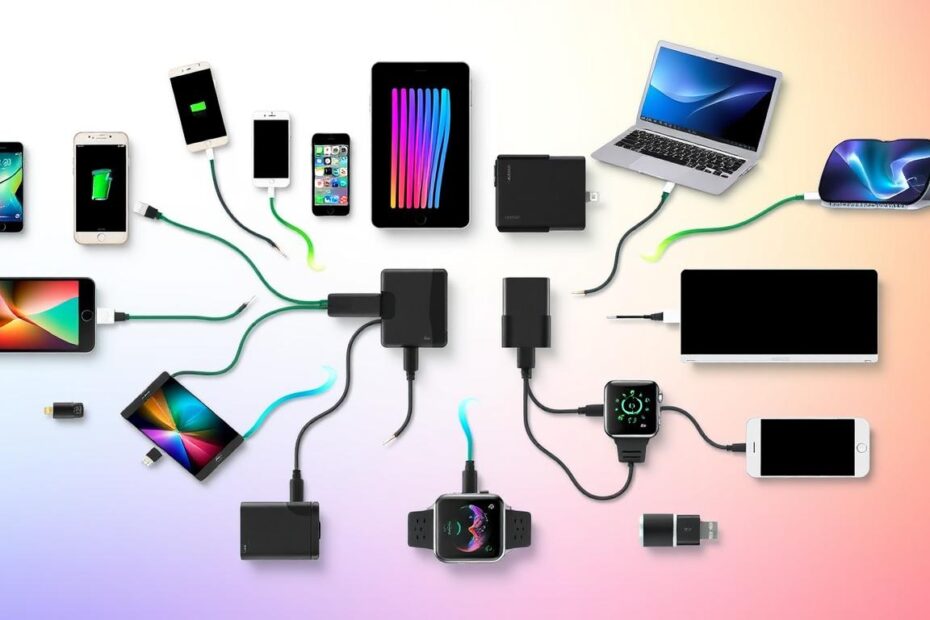As someone who loves tech, I’ve faced the challenge of finding the right charger. It’s easy to grab any charger that’s nearby. But, using the wrong charger can harm your devices. We’ll look into what makes a charger safe and effective for your gadgets.
Key Takeaways
- Charger compatibility is crucial for the safety and performance of your electronic devices.
- Different types of chargers, including laptop chargers, Apple’s Lightning connector, Micro-USB, and USB Type-C, have varying specifications and requirements.
- Understanding the relationship between volts, amps, and watts is essential when selecting the right charger for your device.
- Using a non-compatible charger can potentially damage your device and void its warranty.
- Staying informed on the latest charging technology trends, such as fast charging and wireless charging, can help you make informed decisions about your charging needs.
Understanding Device Chargers
At the heart of our electronic devices lies a crucial component – the charger. This unassuming device plays a vital role in keeping our gadgets powered and ready for use. But what exactly is a charger, and how do different types work with our devices?
What Is a Charger?
A charger is a power adapter that supplies electrical energy to rechargeable batteries or electronic devices. It converts the alternating current (AC) from a wall outlet into the direct current (DC) needed by the device’s battery or internal components. Chargers come in various shapes, sizes, and power ratings. They are designed to meet the specific needs of different power adapters, voltage compatibility, and device charging requirements.
Types of Chargers Available
- Laptop chargers: These power adapters are designed specifically for laptop computers, providing the necessary voltage and amperage to charge and power the device.
- Micro-USB chargers: A widely used connector found in many mobile devices, including Android phones and tablets.
- USB Type-C chargers: The newer and more versatile USB standard, capable of higher power delivery and faster data transfer.
- Apple’s Lightning connector: Used for iOS devices like iPhones and iPads, offering a proprietary charging solution.
How Chargers Work with Devices
Chargers work by converting the AC power from a wall outlet into the appropriate DC power required by the device. This conversion process involves understanding the voltage, current, and power that the device needs to function properly. Choosing the right charger that matches the device’s voltage compatibility and power requirements is crucial for ensuring safe and efficient device charging.
“The new iPhone 12 can handle up to 20W charging, which is significantly faster than using a 5W charger from Apple for the same device.”
Compatibility Between Chargers and Devices
It’s crucial to match chargers with devices for safe and efficient charging. Each device has its own voltage and amperage needs. The charger must meet these to avoid damage or poor performance.
Why Compatibility Matters
Using the wrong charger can cause problems like slow charging, overheating, or damage to your device. Chargers that don’t match your device’s needs can disrupt its power system.
Supported Voltage and Amperage
Check the voltage and amperage of your device and charger for compatibility. Most devices need voltages from 5V to 20V and amperages from 0.5A to 3A. A charger with higher amperage can charge devices with lower needs, but not the other way around.
Universal Chargers: Pros and Cons
Universal chargers are handy for charging different devices with one charger. Yet, they might not charge as fast or efficiently as needed. Always check if a universal charger fits your device’s voltage and amperage before use.
| Charger Type | Voltage Range | Amperage Range | Compatibility |
|---|---|---|---|
| Samsung Adaptive Fast Charging | 5V – 12V | 2A – 3A | Compatible with Galaxy S24, S23, S22, S21, Note20, S20, Note10, Z Fold 2/3, A71, A53 |
| Samsung Adaptive Fast Charging | 5V – 9V | 2A – 2.4A | Compatible with Galaxy Z Fold, Z Flip, S10, Note9, Note8, S9, S8, A70, A50, A51, A52 5G, A42 5G, A32 5G, A13, A12, A02s |
| USB Power Delivery (USB-PD) | 5V – 20V | 3A – 5A | Compatible with various smartphones, laptops, and other USB-C devices |
Knowing how chargers and devices match up helps ensure safe and efficient charging. This can also extend the life of your devices.
Risks of Using Generic Chargers
Generic chargers might seem like a good deal, but they can be risky for your devices. They can cause many problems that harm your gadgets’ safety and life span.
Common Issues with Non-Original Chargers
Generic chargers often charge slower than the ones made by the device’s maker. This can be annoying when you need to charge your device fast. Also, they might not have the safety features needed, which can lead to overheating or battery damage.
Potential Damage to Your Device
Using a generic charger can damage your device. Lithium-ion batteries in phones, laptops, and tablets are especially at risk. They can get damaged from overcharging or the wrong voltage, causing battery problems, shutdowns, or even fires.
Warranty Considerations
Using generic chargers can also affect your device’s warranty. Many makers say using non-approved chargers can void the warranty. So, if your device has problems because of a generic charger, you might not get help from the maker.
To keep your devices safe and working well, always use the charger recommended by the maker. Or, choose a high-quality, certified charger. Spending a bit more on the right charger can save you from expensive fixes or the hassle of a broken device later.
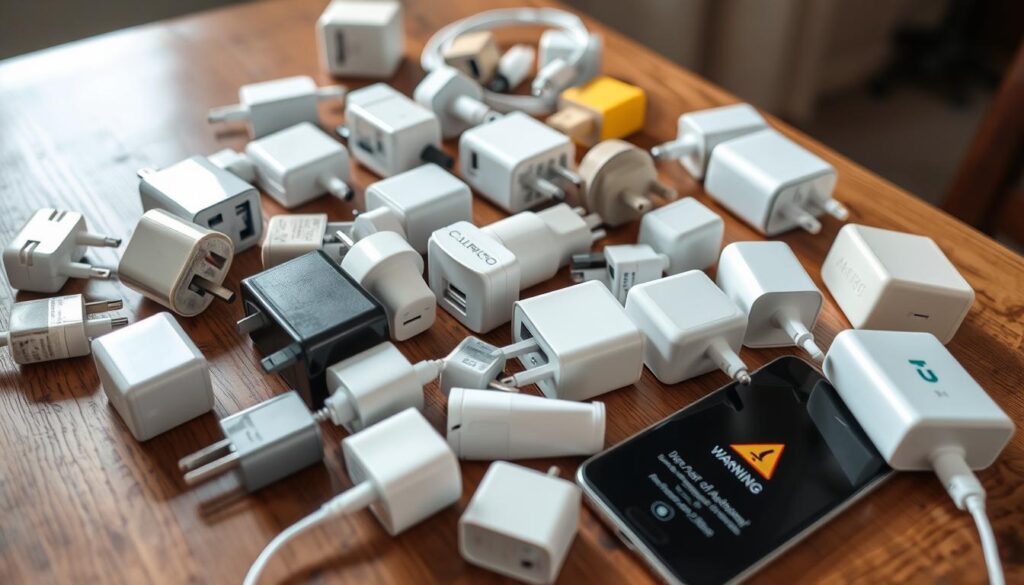
Specifics for Cell Phones
Cell phones have changed a lot in how they charge. Now, we have many charging standards and fast charging options. This makes it quicker to charge our phones. Knowing about these changes helps us charge safely and efficiently.
Different Charging Standards for Phones
There are several charging standards for smartphones today:
- USB Power Delivery (USB PD): A universal standard for fast charging up to 100W, works with many devices.
- Qualcomm Quick Charge: A fast charging tech from Qualcomm, charges up to 65W quickly.
- Lightning: Apple’s charging standard for iPhones and iPads, charges up to 20W.
- USB-C: The newest universal port, charges fast and transfers data up to 100W.
Fast Charging Technologies
Fast charging has changed how we charge our cell phones. Qualcomm’s Quick Charge 4+ and 5, and USB Power Delivery (USB PD) lead the way. They can charge up to 65W, making charging much faster. But, it’s key to use the right charging cables and adapters to get the most out of these speeds.
Best Practices for Safe Charging
To charge your cell phone safely and efficiently, follow these tips:
- Use the original or certified charging equipment your device maker recommends.
- Don’t charge your phone in extreme temperatures, as it can harm the battery.
- Don’t overcharge your phone, as it can shorten your battery’s life.
- Take your phone off charge once it’s fully charged to protect the battery.
By knowing about different charging standards, using fast charging, and charging safely, your cell phone will always be ready to use.
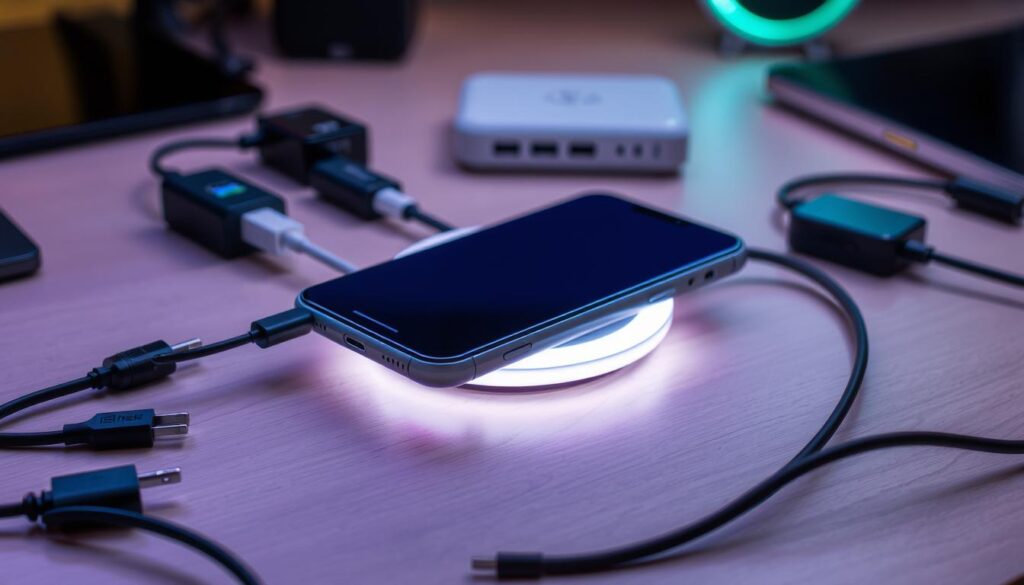
Chargers for Laptops
Charging laptops needs a good understanding of power needs and compatibility. Laptops need more power than smartphones, often needing special chargers. Even though USB-C charging is getting popular, many laptops still need chargers made just for them.
Power Requirements for Laptops
Laptop charging needs vary by model, from 45 watts to 240 watts. USB-C Power Delivery (PD) ports can handle up to 100 watts. But, it’s best to use at least a 45-watt charger. Faster charging is possible with 65-watt or 100-watt chargers.
Brand-Specific Chargers vs. Generic Options
Many laptops need chargers made just for them. While generic USB-C chargers might work, they might not charge as well. It’s safer and better to use chargers made for your laptop model.
Is It Safe to Use a Phone Charger for a Laptop?
Using a phone charger for a laptop is usually safe. But, it might charge slowly or not at all because of low power. Portable laptop chargers with AC outlets can give up to 100 watts of power. Make sure the charger’s power matches your laptop’s needs to avoid problems.
| Charger Type | Power Output Range | Advantages | Disadvantages |
|---|---|---|---|
| Brand-Specific Laptop Charger | 45W – 240W |
|
|
| USB-C Laptop Charger | 45W – 100W |
|
|
| Phone Charger | 5W – 30W |
|
|
When it comes to laptop charging, it’s key to know your device’s power needs. Choose a charger that fits, whether it’s a brand-specific charger or a USB-C laptop charging option. The right charger ensures your laptop charges safely and efficiently.
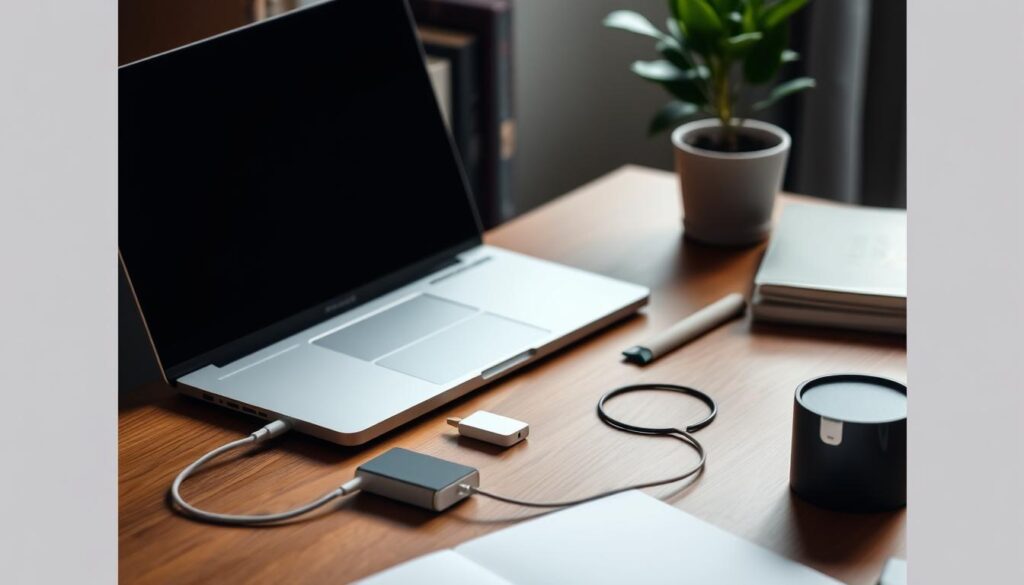
Charging Cameras and Tablets
It’s crucial to use the right charger for your camera or tablet to avoid problems. Cameras need specific batteries with unique charging needs. Tablets usually use the same charging standards as smartphones but might need more power.
Understanding Camera Battery Specifications
Cameras have different battery types, each with its own charging needs. Before buying a charger, check the battery’s voltage and amperage. A charger that doesn’t match these specs can cause slow charging or damage the battery.
Tablet Charger Compatibility
Most tablets use micro-USB or USB-C ports, like many phones. But, tablets often need more power to charge. Using a charger with lower amperage can make charging take longer or stop it altogether.
How to Choose the Right Charger
When picking a charger, focus on the device’s voltage and amperage specs. Choose a charger that matches these to ensure fast charging and protect your device. Using the charger that came with your device or a branded replacement is best. These are made to work perfectly with your device.
| Device | Voltage | Amperage |
|---|---|---|
| Camera (Model A) | 5V | 2A |
| Tablet (Model B) | 9V | 3A |
Knowing the charging needs of your camera and tablet helps you pick the right charger. This ensures your devices stay powered and perform well.
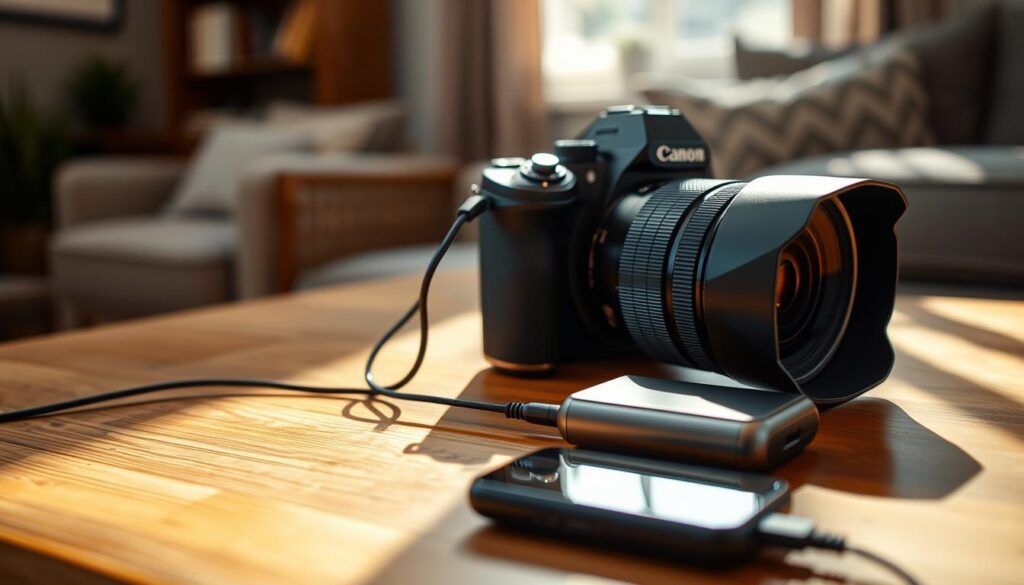
How to Identify Compatible Chargers
Charging your devices right is key. You need to make sure the charger fits your device. Check your device’s specs and use a voltage meter to confirm the charger’s output.
Checking Device Specifications
First, look at your device’s manual or the manufacturer’s website. Find out the voltage and amperage it needs to charge. This info helps pick a charger that’s just right for your device.
Using Voltage Meters
A voltage meter is handy for checking charger compatibility. It measures the charger’s voltage and amperage. This ensures it’s safe for your device.
Tips for Selecting a Suitable Charger
- Look for chargers with certifications like UL or CE to ensure they meet safety standards.
- Choose a charger that matches or exceeds the voltage and amperage requirements of your device.
- Consider using the original charger provided by the manufacturer, as it is designed specifically for your device.
- Beware of generic or counterfeit chargers, as they may not provide the proper power output and could potentially harm your device.
By following these steps, you can find chargers that are just right for your devices. This keeps them powered and safe.
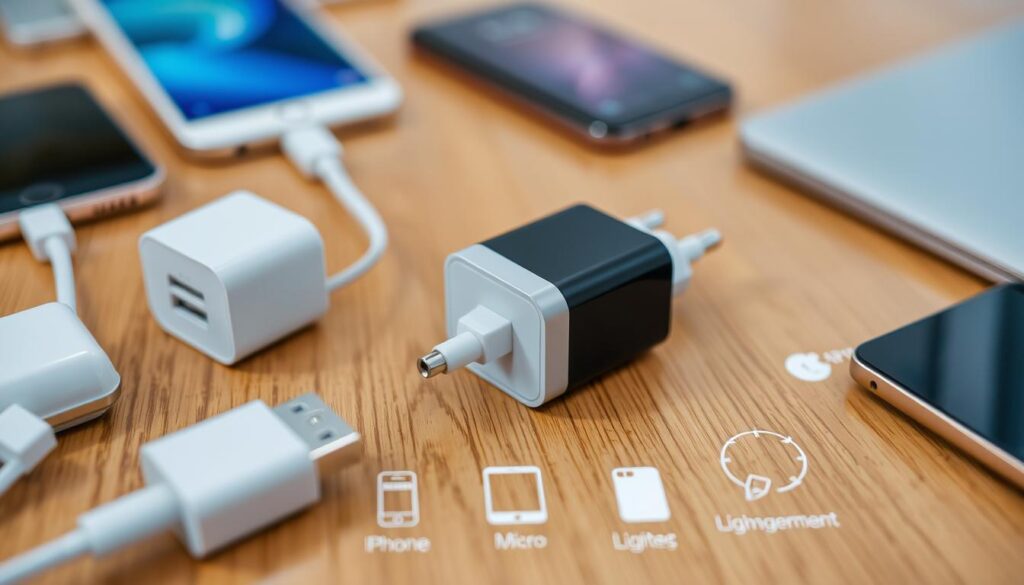
The Future of Charging Technology
The world of electronics is always changing, and charging technology is no exception. New trends are making charging faster and more universal. This is because people want to charge their devices quickly and easily.
Trends in Charger Innovation
One big trend is making chargers faster. Companies are working hard to charge devices quicker. This includes using USB Power Delivery and Gallium Nitride (GaN) chargers.
Wireless Charging: What You Need to Know
Wireless charging is becoming more popular. It’s convenient because you don’t need cords. But, it might not charge as fast as wired charging.
The Move Towards USB-C Standardization
USB-C is becoming the standard for charging. Introduced in 2014, it’s now used in many devices. It offers faster speeds and is becoming a common connector.
The future of charging looks bright. We’ll see more charging technology trends, wireless charging, and USB-C standardization. This will make charging easier and more efficient for everyone.
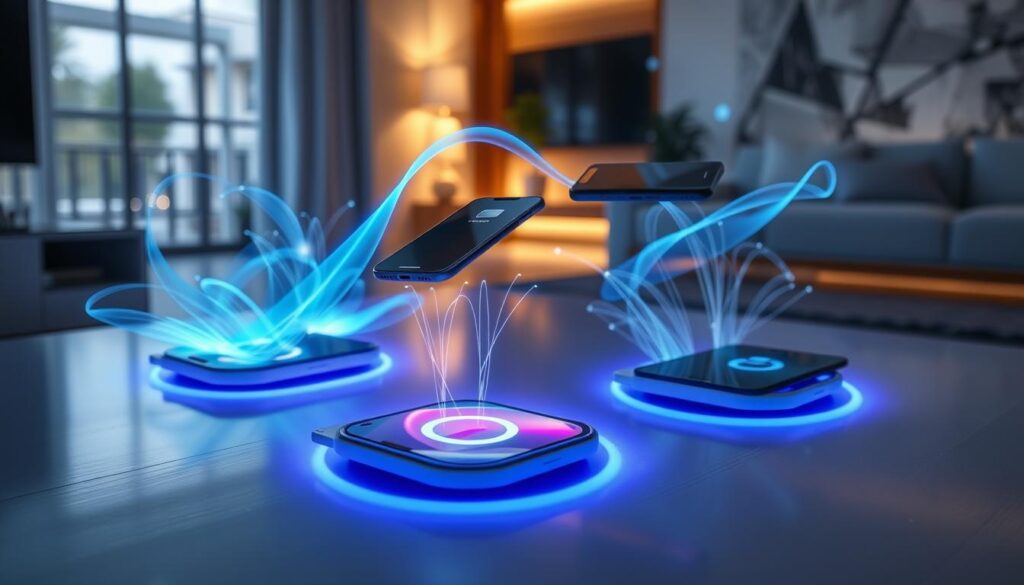
Eco-Friendly Charging Solutions
Our use of electronic devices is growing fast. It’s important to think about how our charging habits affect the planet. Eco-friendly charging solutions aim to cut down on waste and use less energy. This helps make our planet a greener place for the future.
Importance of Sustainable Chargers
Sustainable chargers are made to be kinder to the environment. They’re often built from recycled materials, saving natural resources. These chargers also use smart tech to lose less power, which means less energy used and fewer emissions.
How to Dispose of Old Chargers Properly
- Recycle old or unused chargers to keep them out of landfills.
- Look up your local recycling program or check with your device maker for disposal tips.
- Don’t throw chargers away, as they can harm the environment.
Choosing Energy-Efficient Options
When picking a new charger, choose ones that are Energy Star certified or have energy-saving features. These chargers use less power, which is good for the planet and can save you money on your bills.
| Product | Features | Price |
|---|---|---|
| Omni 20+ Portable Charger |
|
$249.00 |
| Goal Zero Venture 35 Solar Power Bank |
|
$99.95 |
Choosing sustainable charging options is good for the planet and your devices. It makes sure your gadgets are charged well and efficiently. By choosing eco-friendly options, you help make the world a greener place.
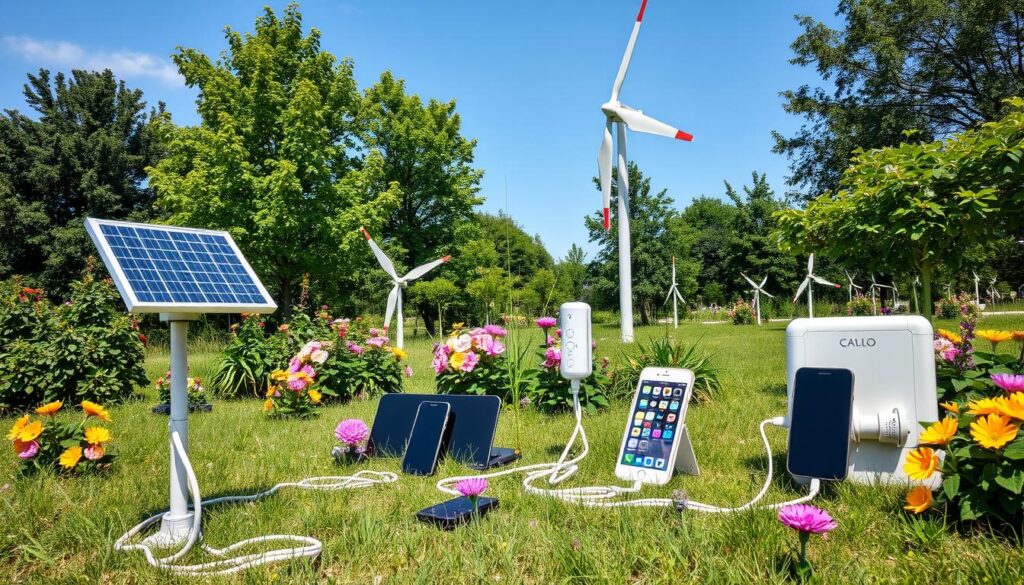
Conclusion: Charging Your Devices Safely
In this article, we’ve looked into the world of device charging. We’ve seen why using the right, high-quality chargers is key. It keeps your devices safe and working well for longer.
Recap of Key Points
Using chargers made for your device is a must. They match the voltage and amperage your device needs. While universal chargers are handy, they might not be the best choice. They could harm your devices.
It’s also important to not overcharge your devices. Keep them away from heat. And, throw away old chargers to protect the environment.
Best Practices for Charging
Always check your device’s manual for charging tips. Don’t use cheap, fake chargers. They can be dangerous for your device and you.
Choose high-quality, brand-name chargers instead. They are made to work well with your devices. This way, you charge your devices safely and efficiently.
Final Thoughts on Charger Compatibility
Knowing about charger compatibility is vital for safe charging. By choosing the right chargers and following the right practices, you can charge your devices easily and safely. Always put your device and personal safety first when charging.
FAQ
Can I use any charger with my cell phone, laptop, camera, or tablet?
It’s important to match chargers with devices for safe charging. Devices need specific voltages and amperages. Using the wrong charger can slow charging or even harm your device.
What are the different types of chargers available?
There are many chargers out there. You’ll find laptop chargers, Apple’s Lightning connector, Micro-USB, and USB Type-C. These chargers change AC power from wall outlets to DC power for your devices.
How do I know if a charger is compatible with my device?
Check your device’s manual or the manufacturer’s website for voltage and amperage needs. You can also use a voltage meter to check if the charger’s output is right for your device.
What are the risks of using a generic or non-original charger?
Generic chargers can slow down charging, damage your device, and lack safety features. They might also void your device’s warranty.
How do fast charging technologies work, and what do I need to use them?
Fast charging, like USB Power Delivery and Qualcomm Quick Charge, charges batteries quickly. But, you need compatible chargers and devices for it to work.
Can I use a phone charger for my laptop?
Using a phone charger on a laptop is usually safe. But, it might charge slowly or not at all because of low power output. It’s best to use your laptop’s brand-specific charger for the best performance and safety.
How do I dispose of old chargers properly?
It’s important to dispose of old chargers the right way for the environment. Look for eco-friendly charging options. Dispose of old chargers through e-waste collection programs to reduce environmental harm.
What are the latest trends in charging technology?
New charging tech aims for faster speeds and universal use. Wireless charging and USB-C are becoming popular. They might replace old connectors.
Source Links
- USB-C charging laptops: Here’s what you need to know
- Is it Safe to Use Any Charger With Any Phone? The Difference Between 2
- Why It Matters Which Charger You Use for Your Phone
- Different Phone Charger Types & What They Are Used For: Complete Guide
- Wall chargers and charging your Galaxy phone or tablet
- What is a USB-C charger & how to choose the right one? | Belkin US
- Beware the hazards of charging – and over-charging – devices – The Cincinnati Insurance Companies blog
- Using the wrong USB-C cable can damage your tech. Here’s how to avoid that
- Different Types Of Charging Cables For Apple And Android
- How to pick the right charger: A practical guide
- The Best Portable Laptop Charger
- Can You Use Any Charger With Any Cell Phone, Laptop, Camera, or Tablet?
- Long-awaited common charger for mobile devices will be a reality in 2024 | News | European Parliament
- Identify the correct charger for your Galaxy phone
- Identifying Your USB Connector and Cable Types | A Full Guide
- Charge and connect with the USB-C port on your iPad – Apple Support
- No Phone Charger or Outlet? There’s Another Way to Give Your Device a Power Boost
- USB-C Charger: Shaping the Future of the Tech World
- How To Charge a Phone Without Electricity
- Portable Laptop Charger | Omni 20+ Power Bank | Omnicharge
- Solar Power Bank Kits, Portable Solar Phone Chargers | Goal Zero
- Different Types Of Charging Cables For Apple And Android
- Charge camera battery with USB: What should you know about?
- The Truth About Fast Charging: Is It Harming Your Phone?
